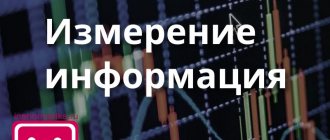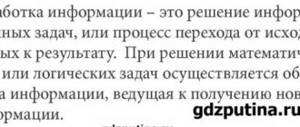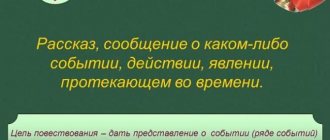Development of a computer science lesson, grade 10 “Information storage”
Lesson summary for 10th grade. Topic "Information storage"
Purpose of the lesson: to introduce students to the types of information media
Tasks:
Educational: comprehend the concept of “information carrier”, distinguish between types of information carriers according to the classification and form of recorded information.
Developmental: develop cognitive interest, attention.
Educational: to develop independence and responsibility when working on a computer.
Lesson type: lesson on gaining new knowledge
Lesson type: combined
Equipment and teaching aids: computer, projector, presentation, interactive whiteboard.
Lesson plan.
1. Organizational stage. (2 minutes)
2. Updating knowledge and subjective experience of students. (5 minutes)
3. Formation of new knowledge (15 min)
4. Consolidation of new knowledge. Work in groups (15 min)
5. Lesson summary (5 min)
5. Homework (3 min)
During the classes.
2. Updating knowledge and subjective experience of students. (5 min)
— Guys, let's remember the material from previous classes:
— What is information?
— Does the information have a material basis?
— What do you think was used in primitive times to store information?
— The amount of information that a person used was constantly and steadily increasing. But, unfortunately, people forget a lot. Therefore, since ancient times, people have been recording information in order to use it many times and then pass it on to their descendants. Let's remember what inventions of mankind helped people in the future to store quite large amounts of information? ( Presentation “Information storage”, slide 1
)
- So, as you probably already guessed, the topic of our lesson is “ Information Storage”
«
Slide 2.
— This is information, knowledge, messages, signals, i.e. everything that is used to control a situation, behavior, organization, state.
- No
— Human memory
— Stone, papyrus, birch bark, parchment and paper
Students write down the topic of the lesson in their notebooks.
3. Formation of new knowledge. (15 min)
— Starting from the mid-19th century, the century of the birth of the computer as a means of information processing, it became possible to store even larger amounts of information. How do we store information now?
- In any case, the information is stored on some kind of media, because... information is not material. And this medium must have “memory”, i.e. able to maintain its condition for a long time. So, we are ready to give the concept of an information carrier. Let's write down the definition. “ Information carrier (information carrier) is any material object or medium used for storing or transmitting information .” (slide 3)
— Information can be stored on stone, wood, glass, fabric, sand, human body, etc. But we will not discuss various historical and exotic carrier options. ( slides 4-5
).
We will limit ourselves to modern means of information storage that have widespread use.
— The most widely used medium is still paper. Invented in the 2nd century AD. In China, paper has served people for 19 centuries. But time passes, and the quality of paper media has ceased to suit modern society, concerned with the ever-increasing amount of information that needed to be preserved and passed on to descendants.
Why has paper ceased to satisfy modern society as an information carrier?
— For these purposes, storage devices were invented, the main advantage of which was the possibility of repeated rewriting of information and long-term storage of information. Paper media began to be gradually replaced, first by analog, and then by digital storage devices.
- Now, using the original data on the slide, try to make a classification of information carriers. ( slide 6
)
— Magnetic disks, laser disks, flash drives
Students write down the definition in their notebooks.
1. Small capacity 2. The forest is being cut down 3. Cannot be overwritten
A student is invited to the board and, using the Drag&Draw method, draws up a classification scheme for modern media. Students sketch the diagram in their notebook.
4. Consolidation of new knowledge. Work in groups (15 min)
— And now I suggest you fill out the table Appendix 2
"Digital media", using reference material.
(Reference material can be offered in electronic form or printed. As reference material, you can use interactive modules of the Internet resource fcio.edu.ru)
see Appendix 1
.
When the entire table is filled out, the teacher prints out the finished table and distributes it to students.
Students are divided into 5 groups. Each group needs to fill out part of the general table, namely, write down all the characteristics of one of the storage media. As each group is ready, one of its participants comes to the board and fills out their part.
Then the students, together with the teacher, discuss the correctness of filling out the table and correct any inaccuracies.
5. Lesson summary.
- So, guys, let's remember what we did in class today.
— We got acquainted with the concept of an information carrier.
— Carried out a classification of media
— Filled out the table with the main characteristics of digital media.
6. Homework
§7. Questions for paragraphs 5, 6, 10. Assignment on cards. Appendix 3
.
The lesson is over. Goodbye.
LITERATURE: N.D. Ugrinovich “Informatics: Textbook for grade 10”, Moscow, BINOM, Knowledge Laboratory, 2009, §1.6, pp. 25-28
“Informatics lessons in grades 8-10: Methodological manual, Moscow, BINOM, Knowledge Laboratory, 2012, pp. 106-110.
Types of information: https://www.fio.by/vypusk/Potok_63/group_4/user_7/pages/inf2.htm b) Information around us: https://www.fio.by/vypusk/Potok_63/group_4/user_7/ pages/inf1.htm c) Nonverbal elements in communication: https://www.zachetka.ru/referat/preview.aspx?docid=76978_page=10
Lesson plan.
1. Organizational moment.
(Welcome, check on those present, explain the progress of the lesson.)
2.Motivation.
Explanation of the topic, purpose, lesson plan (transfer, storage, processing)
Lesson topic: “Information storage; choosing a method for storing information. Transfer of information. Communication channel and its characteristics."
3. Updating knowledge.
Understanding the world around us, each of us forms our own idea of it. Every day we learn something new - we receive information. The term “information” translated from Latin means “explanation, presentation, set of information.” Remember what properties of information that are significant for a person we highlighted in previous lessons (useful, understandable, relevant, complete, reliable).
Remember how a person perceives information (all this information is conveyed to a person’s consciousness by his senses: vision, hearing, smell, taste and touch).
Review questions:
1.What is information? /Information is information about the world around us (everything that surrounds us)/.
2.What actions does a person perform with information? /A person constantly performs actions related to receiving and transmitting, storing and processing information./
3. Information processes are...?
4. What is a code?
A code
is
a system of symbols for representing information.
5. What is coding?
Coding
is
the formation of a representation of information using some (or we can say that
coding is a transition from one form of information representation to another, more convenient for
storage, transmission or processing).
6.What is decoding? Give examples.
Decoding -
This is the process of reconstructing the content of encoded information. Why do people decode information?
«Decoding words by letter numbers"
9 15 1 12 (sign); 14 29 26 30 (mouse)
Individual work of students:
TEST: "Information"
Draw arrows from the signs to the corresponding sense organs.
You know that information is received through various channels. Each type of information has its own channel.
- How can you get information using your senses? What kind of information?
-Carry out an observation (experiment) and fill in the proposed table.
-With the help of which sense organ does a person receive the greatest amount of information?
- Item
Look at the pictures and determine through which channels and through which sense organs the information was received?
Observe the people around you and draw faces in ovals that expressed the following emotions: joy, sadness, indignation, surprise.
Conclusion: information does not exist by itself. It is determined in information processes.
4. Studying a new topic.
Theoretical part.
A computer is an electronic device designed to work with information through automated recording, storage, reception, transmission, processing and reproduction of data.
Data concept.
All natural phenomena are accompanied by energy exchange. During its course, bodies release and absorb energy. Energy exchange is characteristic of all known natural processes: physical, chemical, biological and their combinations.
Energy travels in the form of signals. When signals interact with matter, the states and properties of material bodies change. If a change is recorded, it is said that a signal has been recorded. This is how data is generated. Data are recorded signals of any physical nature.
Text on paper is the recorded result of the interaction between paper and dye. Recording on magnetic tape is the recorded results of changes in the magnetic field near the recording magnetic head. Craters on the Moon are the recorded results of the interaction of cosmic bodies with its surface. Craters on Earth are the recorded results of activity within the planet's interior.
Information
. When they say that computers are designed to work with information, they mean that information is contained in data. Computers work only with data, and information is formed at the moment of interaction of data with information methods.
The word “information” comes from the Latin word informatio, which means information, explanation, familiarization. The concept of “information” is basic in a computer science course; it is impossible to define it through other, more “simple” concepts. In geometry, for example, it is impossible to express the content of the basic concepts “point”, “ray”, “plane” through simpler concepts. The content of basic, basic concepts in any science should be explained with examples or identified by comparing them with the content of other concepts.
In the case of the concept “information”, the problem of its definition is even more complex, since it is a general scientific concept. This concept is used in various sciences (computer science, cybernetics, biology, physics, etc.), and in each science the concept of “information” is associated with different systems of concepts.
Information in biology.
In biology, which studies living nature, the concept of “information” is associated with the appropriate behavior of living organisms. This behavior is based on the body’s receipt and use of information about the environment.
The concept of “information” in biology is also used in connection with studies of the mechanisms of heredity. Genetic information is inherited and stored in all cells of living organisms. Genes are complex molecular structures that contain information about the structure of living organisms. The latter circumstance made it possible to conduct scientific experiments on cloning, that is, the creation of exact copies of organisms from one cell.
Information in cybernetics
. In cybernetics (the science of management), the concept of “information” is associated with control processes in complex systems (living organisms or technical devices). The vital activity of any organism or the normal functioning of a technical device depends on control processes, thanks to which the values of their parameters are maintained within the required limits. Management processes include receiving, storing, transforming and transmitting information.
Information in society
. Man is a social being; in order to communicate with other people, he must exchange information with them. In everyday life, information is information, a message, awareness of the state of affairs.
Thus, information in computer science is:
Information
is a person’s knowledge (declarative - “I know that ...” and procedural - “I know how ...”), which he receives from the outside world and which he implements with the help of computer technology.
A person’s memory stores information about everything he saw, heard, felt or experienced. People store information on different media and create libraries and media libraries to store information. What is this all for?
Information processes.
Processes associated with the collection, storage, retrieval, processing, encoding and transmission of information are called information processes.
Collection of information.
(slide 2-6)
We have to admit that the senses, our main tool for understanding the world, are not the most perfect devices. They are not always accurate and are not able to perceive all information. It is no coincidence that rough, approximate calculations are referred to as “by eye.” If there were no special instruments, it is unlikely that humanity would have been able to penetrate the secrets of a living cell or send space probes to Mars and Venus.
All human activities are associated with various actions with information, and various technical devices help him in this. Any scientific knowledge begins when we can evaluate the information received, compare it, and therefore measure it. Therefore, special technical devices are widely used to obtain information inaccessible to ordinary senses.
One of the oldest structures used to obtain astronomical information is located in England near the city of Salisbury. This is Stonehenge - the “hanging stones”. It was built around the 2nd century BC. e. Stonehenge consists of vertical stone pillars arranged in concentric rings. On vertical stones there are horizontal crossbars, a kind of arches. In 1963, using the latest research methods, it was established that stone arches give directions to the extreme positions of the Sun and Moon, and 56 white holes help predict the time of Solar and Lunar eclipses.
One of the oldest devices is the scale. With their help, people obtain information about the mass of an object. Another old friend of ours - a thermometer - is used to measure the temperature of its environment.
Data processing. (slide 7-8)
Data processing
- this is the receipt of some information objects from others by performing certain actions. Gaining life experience, observing the world around him, in other words, accumulating more and more information, a person learns to draw conclusions. In ancient times, people said that a person knows with the help of his senses and comprehends what he knows with his mind.
Once we touch a hot kettle or iron, we remember it for the rest of our lives. Every time we accidentally touch a hot surface, we pull our hand away, because we all had our own “hot kettle” in childhood. If we analyze why this happens, we can draw a conclusion about the transformation (processing) of information. By touching a hot surface, we received information through the senses of touch. The nervous system transmitted it to the brain, where, based on existing experience, a conclusion was made about the danger. A signal from the brain was sent to the arm muscles, which instantly contracted. Similar processes of information processing occur at the moment when, at the very first chords of a familiar melody, the mood immediately improves or tears appear. All these are examples of unconscious information processing, which is carried out as if “besides us”, unconsciously.
There are many examples of conscious information processing. In this case, a person creates new information based on incoming information - the so-called input information - and on the stock of knowledge and experience he has. For example, in chemistry lessons, a student learns rules and laws (acquires certain knowledge and skills). When the teacher offers the next problem (input information), the student thinks about the sequence of the solution, remembering which of the learned rules he needs to apply. Finally, he finds the answer. This new information created by the student as a result of processing the input information is called output.
Thus, output information is always the result of human mental activity in processing input information. We can say that a person is constantly processing input information, transforming it into output.
|
|
|
|
|
|
|
|
| |
| |
|
|
| |
|
|
| |
| |
| |
|




